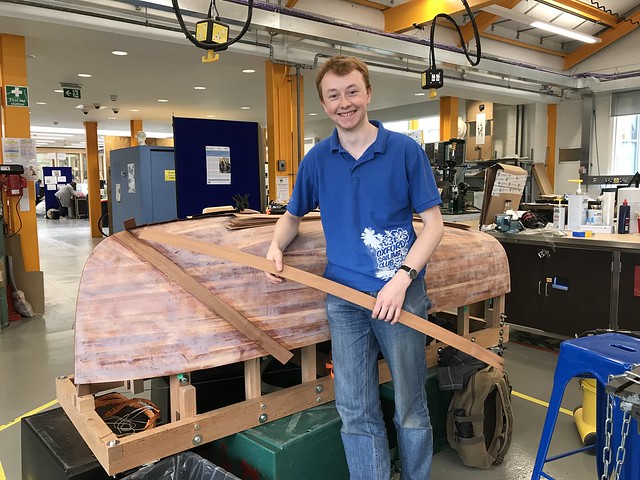Alastair Gregory finished writing up his PhD earlier this summer and found himself with a window of time before he starts his Postdoctoral researcher post. He decided to build a boat.
So much of design is like play, making mistakes and getting it wrong is one of the ways you learn. The Dyson Centre for Engineering Design is all about enabling the students to do just that.
Alastair Gregory
This is Alastair's second boat build and for him it is an enjoyable challenge which he hopes might also show the undergraduates how a project like this can be achieved and how the Dyson Centre for Engineering Design can support such an endeavour in terms of space and equipment. He says “So much of design is like play, making mistakes and getting it wrong is one of the ways you learn. The Dyson Centre is all about enabling the students to do just that.”
The Dyson Centre for Engineering Design is a modern workspace where engineering students can come together outside of the classroom to think, experiment, design, build and exchange ideas. A space for hands-on learning, access to information, and the encouragement of creativity and innovation. There are numerous resources for students to use including 3D printing, laser cutting, plasma cutting, Computer Aided Design (CAD) systems, metalwork bench spaces and woodwork bench spaces.
Alastair’s PhD was in Biomedical engineering, his supervisor was Anurag Agarwal. During his undergraduate degree Alastair specialised in fluid mechanics and acoustics and his PhD explored breathing in the chest, how wheezing sounds are produced, understanding the mechanism behind those sounds with the aim of improving diagnosis of what these sounds mean. Stethoscopes are very cheap and not invasive but they are also not able to accurately identify one sound from another so Alastair and his team in the Acoustics Lab aim to improve them whilst taking advantage of the fact that they are so easy to use.
Alastair concentrated on studying wheezing sounds for his PhD and he found a mechanism for identifying these, and he and his team are publishing some papers on this. He will be continuing with this work but broadening this research on his Junior Research Fellowship from Magdelene College starting in October. He will explore other types of sounds such as bowel, sounds associated with muscles and heart sounds, using a mixture of techniques. To date Alastair has concentrated on understanding sound mechanisms and he will be moving on to look at how to diagnose based on those sounds using machine learning based approaches.


